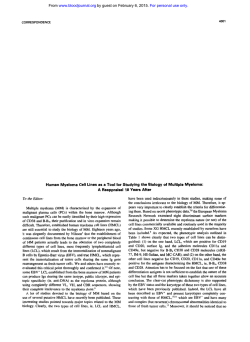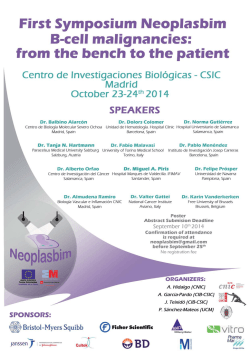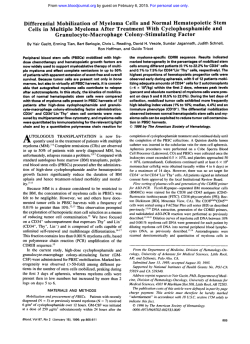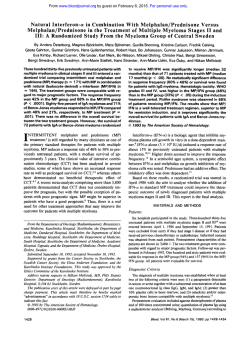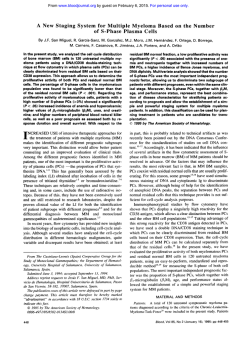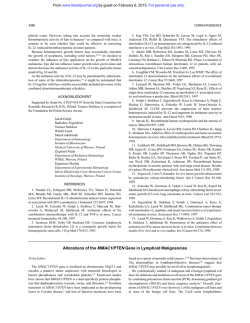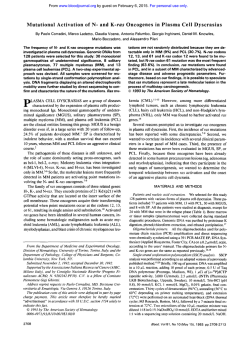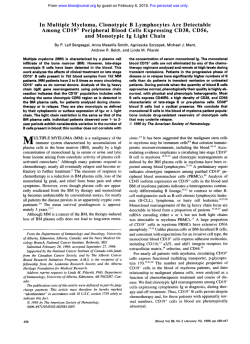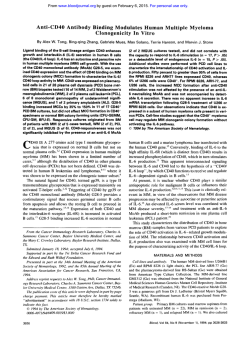
Primary Dexamethasone Treatment of Multiple Myeloma
From www.bloodjournal.org by guest on February 6, 2015. For personal use only. RAPID COMMUNICATION Primary Dexamethasone Treatment of Multiple Myeloma By Raymond Alexanian, Meletios A. Dimopoulos, Kay Delasalle, and Bart Barlogie Intermittent courses of dexamethasone (DEX) were administered to 112 consecutive, previously untreated patients with multiple myeloma (MM). Using criteria based on a 75% or greater reduction of calculated tumor mass, the overall response rate was 43%. Among comparable patients, response rates were approximately 15% less than those observed previously with vincristine-doxorubicin by continuous infusion with intermittent DEX (VAD) and similar to those with melphalan-prednisone. The projected survival times with VAD or DEX were similar. Results indicated that DEX accountedfor most of the plasma cell reductionachieved with VAD. Serious complications occurred in 27% of patients treated with VAD, but in only 4% of those who received DEX. In view of the similar outcome with fewer serious complications, DEX provided a simple, effective, and safe primary treatment for a large fraction of patients with MM. Patients who appear most likely to benefit include those with hypercalcemia or pancytopenia, or who require simultaneous radiotherapyfor a pathologic fracture. o 1992 by The American Society of Hematology. D unresponsive. Response and survival data were compared with those of a VAD regimen studied immediately before the DEX program in 177 previously untreated patients? Statistical analyses. Patients treated with DEX had less extensive disease than patients treated previously with VAD (Table 1). Consequently, response rates and survival times were assessed in comparable subgroups of patients with similar tumor mass grades. After preliminary analyses showed similar results for patients with either high or intermediate tumor mass, patients in both groups were combined into one category. Survival curves were calculated from the start of treatment by the Kaplan-Meier method, and compared by the Wilcoxon test? URING THE PAST 10 years, several treatments have been found useful for patients with multiple myeloma (MM). The combination of vincristine-doxorubicin by continuous infusion with intermittent dexamethasone (VAD) has reduced tumor mass markedly in about 25% of patients resistant to standard regimens and in about 45% of patients with relapsing Yet, this program did not improve the frequency of response or the survival time of newly diagnosed patient^.^ Dexamethasone alone (DEX) was effective in about one-fourth of myeloma patients with resistant disease, and appeared to account for most of the responses to VAD, but has not been studied in previously untreated patients2 These observations prompted the current study of high-dose DEX in previously untreated patients. Results indicated that this glucocorticoid provided a simple, effective, and safe treatment for many patients with MM. MATERIALS AND METHODS Patients and drug regimens. Between August 1989 and December 1991, DEX was administered to 112 consecutive patients with symptomatic MM. Their clinical features are summarized in Table 1. The DEX dose regimen was 20 mg/m2 each morning for 4 days beginning on days 1, 9, and 17. After a 14-day rest, the treatment was repeated with downward dose adjustments for side effects; the dose was reduced by 20% in seven patients and by 40% in three patients because of uncomfortable hiccoughs, severe hyperglycemia, moderate irritability and insomnia, or oral candidiasis. No more than three cycles of DEX were required to confirm a response. All responding patients were maintained on a interferon (IFN) 2 x lo6 U/mZ subcutaneously every Monday, Wednesday, and Friday. This treatment was conducted after approval by our Institutional Review Board and in accord with an assurance filed with, and approved by, the Department of Health and Human Services. Staging and clinical response. The diagnosis of MM was based on standard criteria; all showed bone marrow plasmacytosis of more than 15%, all but 4% showed a monoclonal globulin on serum or urine electrophoresis, and more than 70% had lytic bone lesions. Plasma cell tumor mass was defined in each patient as high, intermediate, or low. High tumor mass was defined by either serum calcium greater than 11.5 mg/dL or hemoglobin less than 8.5 g/dL. Low tumor mass required normal serum calcium, hemoglobin greater than 10.5 g/dL, and serum myeloma protein less than 4.5 g/dL. All other patients were classified as intermediate tumor mas^.^.^ Clinical response was defined as a 75% reduction of serum myeloma protein production, disappearance of Bence Jones protein, and reduction of marrow plasmacytosis to less than 5%.6 Only two patients died during the first 4 weeks, they were considered Blood, Vol80, No 4 (August 15). 1992: pp 887-890 RESULTS Frequency of response. The overall response rate was 43% with DEX and 55% with previous VAD. Among patients with comparable tumor mass, the frequencies of remission with DEX were approximately 15% less than those achieved with VAD (Table 2 ) . Four of the 10 patients in whom the dose was reduced because of side effects achieved a response, a frequency similar to that of all other patients. The rapidity of response was assessed from serial changes in IgG or IgA myeloma protein production.6 The tumor mass halving times for patients responding to DEX were identical to those of patients responding previously to VAD (median, 0.5 months). All patients responding to VAD or DEX showed a tumor halving time of 3.2 months or less, and a remission was confirmed in 80% of patients within 2 months. Serum myeloma protein disappeared on immunofixation studies in 3% of patients treated with DEX alone, and in 8% of patients treated with VAD (P = .13). From the University of Teras M.D. Anderson Cancer Center, Houston, TX. SubmittedApril20, 1992; accepted June 18, 1992. Supported in part by a grant from the Hompe Myeloma Research Fund. Address reprint requests to Raymond Aleranian, MD, Box 1, 1515 Holcombe Blvd, University of Texas M.D. Anderson Cancer Center, Houston, TX 77030. The publication costs of this article were defrayed in part by page charge payment. This article must therefore be hereby marked “advertisement” in accordance with 18 U.S.C. section 1734 solely to indicate this fact. 0 1992 by The American Society of Hematology. 0006-4971/92/8004-0037$3.00/0 887 From www.bloodjournal.org by guest on February 6, 2015. For personal use only. ALEXANIAN ET AL 888 Table 1. Clinical Features of Patients DEX No. of patients Median age (range) Frequency of complications (YO) Hemoglobin <8.5 g/dL Calcium > 12.0 mg/dL Creatinine >2.0 mg/dL p2 microglobulin >6.0 mg/L Tumor mass (%) High Intermediate Low (1989-1991) VAD (1983-1989)" 112 60 (30-85) 177 61 (22-81) 10 6 12 21 28 23 25 45 15 43 42 39 36 25 'Between 1983 and 1986, VAD was administered to 115 consecutive patients with all tumor mass grades. Between 1986 and 1989, VAD was limited to the 62 consecutive patients with high or intermediate tumor mass. Treatment of nonresponders. A CVAD combination was administered to the first 31 unresponsive patients consisting of vincristine 0.8 mg/m2, doxorubicin 35 mg/m2, and cyclophosphamide 400 mg/m2 intravenously (IV) with DEX 20 mg/m2 orally each morning for 4 days; three patients responded (10%). Twelve subsequent patients received a standard program of intermittent melphalan-prednisonex; three patients responded (25%). Four patients without medical contraindications received an intensive program of etoposide and cyclophosphamide9;two patients responded. Seven patients died before a secondary treatment could be offered and there was insufficient data in nine patients treated elsewhere. Remission and survival. Twelve patients responsive to DEX have relapsed to date despite maintenance treatment with aIFN. Five of ten patients with evaluable data responded to their first exposure to melphalan-prednisone; all five patients remain in remission 3 to 12 months after the start of chemotherapy. None of our previous patients who relapsed to VAD responded to standard therapy, and only those few who received intensive therapy achieved a second remission.gJ0 Among patients with comparable tumor mass, the projected survival times for patients treated with DEX were similar to those of patients treated with VAD (Fig 1). Preliminary analyses also showed similar remission times for responding patients treated with each program. Toxic@. Among the 177 patients treated with VADbased regimens, hospitalization was required in 27% for septic complications due to neutropenia or a central venous catheter. The median nadir level of granulocytes was 8OO/kL between days 10 and 16 after the start of chemotherapy. Central venous catheters were usually retained for Table 2. Response Rates in Previously Untreated Patients With MM Tumor Mass No. Low VAD 177 69% DEX 112 51% / High or Intermediate 50% \ \f f= .08 37%' = .08 longer than 6 months, but premature removal was required in 16% of patients because of thrombosis or infection. Virtually all had symptoms of mild vincristine neuropathy, alopecia, and mild Cushingoid features. Most patients treated with DEX also showed Cushingoid features and/or insomnia, but there was no myelosuppression; other complications attributed to DEX, such as oral candidiasis, herpes lesions, aggravation of diabetes, peptic ulcer, hiccoughs, or quadriceps weakness, each occurred in less than 5% of patients. Hospitalization was required in four patients treated with DEX, two with a perforated diverticulum, one with pancreatitis, and one with pneumonia. There was no significant toxicity with IFN that was adjusted in dose to maintain a normal quality of life. Mild fever, achiness, and fatigue were the most frequent side effects. Patients older than 70 years of age were usually unable to tolerate a dose higher than 2 x 106 U three times weekly, and the dose was reduced to 1 x 106 U three times weekly in four older patients. DISCUSSION Among patients with MM resistant to intermittent courses of melphalan-prednisone, either VAD or DEX achieved remissions in about one-fourth of the patients2 However, primary VAD in newly diagnosed patients did not improve either response rate or survival time in comparison with previous experiences3In this report, we confirm a response rate with DEX that was only about 15% less than that with VAD, suggesting that this steroid accounted for most of the plasma cell reduction achieved with VAD. Results with primary DEX were also similar to those observed previously with primary melphalan-prednisone.8 Resistance to DEX was usually associated with resistance to other standard therapies, a finding also consistent with the similar response rates with DEX, VAD, and melphalan-prednisone. Serious toxicity with DEX was rare in contrast to a trial by others in patients with resistant myeloma,ll perhaps because of our longer rest periods and provision for early dose reduction. The reasonably high response rate with minimal side effects supports the value of DEX alone for many patients, and especially those with hypercalcemia or pancytopenia, or those who require simultaneous radiotherapy for a pathologic fracture. However, among those unlikely to respond to DEX or other standard regimens, more intensive primary chemotherapy should be considered. Based on recent prognostic factor studies,12 such patients include those with high serum lactate dehydrogenase, hypodiploidy, or plasma cell leukemia, who represented 24% of our patients and among whom only 21% responded to DEX- or VAD-based regimens. When patients who responded to DEX relapsed despite IFN maintenance, the myeloma responded again to standard chemotherapy in about one-half of the patients. Such preservation of sensitivity differed from previous trials in patients maintained on VAD when more intensive treatments were necessary to induce a remis~ion.~OJ~ This difference is due to the universal resistance to standard chemotherapy of myeloma that progresses despite VAD, in comparison with the frequent sensitivity of myeloma that relapses despite IFN. Thus, the capacity to reduce and From www.bloodjournal.org by guest on February 6, 2015. For personal use only. DEXAMETHASONETREATMENT OF MYELOMA 889 100 80 <3 z 2 60 4 I- E$ 40 W n VAD 20 B I 20 40 60 80 20 40 MONTHS OF TREATMENT stabilize the myeloma with a sequence of high-dose glucocorticoid and IFN provided an opportunity to observe later responses to the patient's first exposure to an alkylating agent. For those patients at high risk for early relapse and who qualify for a myeloablative treatment, autologous bone marrow or blood stem cells should be collected during remission. Such planning seems essential in view of the reduced mobilization and collection of blood progenitor cells with repeated myelosuppressive therapy.14 The mechanism of myeloma control with glucocorticoids remains unclear. Some have observed a correlation between steroid receptor levels and plasma cell reduction with DEX.15 Others have concluded that the quantity and affinity of glucocorticoid receptors were not predictive of response, and that unknown postreceptor mechanisms accounted for the sensitivity to steroids.I6 Dexamethasone inhibits the messenger RNA expression of interleukin-6 (IL-6) in myeloma cells, a growth factor considered to be a major mediator of plasma cell pr01iferation.l~In view of the probably dominant role of bone marrow stromal cells in the & - Fig 1. Survival from treatment with DEX (- -) or VAD (-) of comparable patients with either high or intermediatetumor mass (A) or with low tumor mass io production of IL-6,18 DEX may induce a plasma cell apoptosis by blocking the IL-6 support network. Regardless of the mechanism, intermittent high-dose DEX provided a simple, effective, and safe primary treatment for nearly one-half of newly diagnosed patients with MM. Responses were rapid in onset, a feature useful in the prompt reversal of complications such as hypercalcemia and renal failure. In contrast to alkylating agents, glucocorticoid treatment has not been associated with secondary leukemia and is more likely to preserve bone marrow function for either high-dose alkylating agent therapy,13or for autologous marrow harvest and an intensive transplantsupported therapy in those who qualify for this procedure.1° Our results also indicate that high-dose DEX is the most effective single agent for MM, with a response rate higher than those observed previously with either intermittent melphalan or IFN.8,19This experience justifies further trials of melphalan with repeated DEX in those newly diagnosed patients who are not candidates for intensive therapies. REFERENCES 1. Barlogie B, Smith L, Alexanian R: Effective treatment of advanced multiple myeloma refractory to alkylating agents. N Engl J Med 310:1353,1984 2. Alexanian R, Barlogie B, Dixon D: High-dose glucocorticoid treatment for resistant myeloma. Ann Intern Med 105:8,1986 3. Alexanian R, Barlogie B, Tucker S: VAD-based regimens as primary treatment for multiple myeloma. Am J Hematol 33:86, 1990 4. Durie B, Salmon S: A clinical staging system for multiple myeloma. Cancer 36:842,1975 5. Alexanian R, Balcerzak S, Bonnet J, Gehan E, Haut A, Hewlett J, Monto R: Prognostic factors in multiple myeloma. Cancer 36:1192,1975 6. McLaughlin P, Alexanian R: Myeloma protein kinetics following chemotherapy. Blood 60851,1982 7. Mantel N: Evaluation of survival data and two new rank order statistics arising in its consideration. Cancer Chemother Rep 50163,1966 8. Alexanian R, Haut A, Khan A, Lane M, McKelvey E, Migliore P, Stuckey W, Wilson H: Treatment for multiple myeloma: Combination chemotherapy with different melphalan dose regimens. JAMA 208:1680,1969 9. Brown R, Herzig R, Wolff S, Frei-Lahr D, Pineiro L, Bolwell B, Lowder J, Harden E, Hande K, Henig G: High-dose etoposide and cyclophosphamide without bone marrow transplantation for resistant hematologic malignancy. Blood 76473,1990 10. Jagannath S, Barlogie B, Dicke K, Alexanian R, Zagars G, Cheson B, LeMaistre F, Smallwood L, Pruitt K, Dixon D: Autologous bone marrow transplantation in multiple myeloma. Blood 761860,1990 11. Friedenberg W, Kyle R, Knospe W, Bennett J, Tsiatis A, Oken M: High-dose dexamethasone for refractory or relapsing multiple myeloma. Am J Hematol36:171,1991 12. Dimopoulos MA, Barlogie B, Smith T, Alexanian R: High serum lactate dehydrogenase as a marker of drug resistance and short survival in multiple myeloma. Ann Intern Med 115:931, 1991 13. Barlogie B, Jagannath S , Dixon D, Cheson B, Smallwood L, Hendrickson A, Purvis J, Bonnem E, Alexanian R High-dose From www.bloodjournal.org by guest on February 6, 2015. For personal use only. 890 melphalan and granulocyte-macrophage colony-stimulating factor for refractory multiple myeloma. Blood 76:677,1990 14. Brugger W, Bross K, Frisch J, Dern P, Weber B, Mertelsmann R, Kanz L: Mobilization of peripheral blood progenitor cells by sequential administration of interleukin-3 and granulocytemacrophage colony-stimulating factor followingpolychemotherapy with etoposide, ifosfamide, and cisplatin. Blood 79:1193,1992 15. Murakami T, Togawa A, Satchi H, Katoh M, Imamura Y, Ohsawa N, Takaku F Glucocorticoid receptor in multiple myeloma. Eur J Haematol39:54,1987 16. Gomi M, Moriwaki K, Katagiri S , Kurata Y, Thompson E: ALEXANIAN ET AL Glucocorticoid effects on myeloma cells in culture. Cancer Res 501873,1990 17. Ishikawa H, Tanaka H, Iwato K, Tanabe 0, Asaoku H, Nobuyoshi M, Yamamoto I, Kawana M, Kuramoto A: Effect of glucocorticoids on the biologic activities of myeloma cells. Blood 75:715,1990 18. Klein B, Zhang XG, Jourdan M, Content J, Houssiau F, Aarden L, Piechaczyk M, Bataille R: Paracrine rather than autocrine regulation of myeloma cell growth and differentiation by interleukin-6. Blood 73517,1989 19. Alexanian R, Gutterman J, Levy H Interferon treatment for multiple myeloma. Clin Haematol2:211,1982 From www.bloodjournal.org by guest on February 6, 2015. For personal use only. 1992 80: 887-890 Primary dexamethasone treatment of multiple myeloma R Alexanian, MA Dimopoulos, K Delasalle and B Barlogie Updated information and services can be found at: http://www.bloodjournal.org/content/80/4/887.full.html Articles on similar topics can be found in the following Blood collections Information about reproducing this article in parts or in its entirety may be found online at: http://www.bloodjournal.org/site/misc/rights.xhtml#repub_requests Information about ordering reprints may be found online at: http://www.bloodjournal.org/site/misc/rights.xhtml#reprints Information about subscriptions and ASH membership may be found online at: http://www.bloodjournal.org/site/subscriptions/index.xhtml Blood (print ISSN 0006-4971, online ISSN 1528-0020), is published weekly by the American Society of Hematology, 2021 L St, NW, Suite 900, Washington DC 20036. Copyright 2011 by The American Society of Hematology; all rights reserved.
© Copyright 2025
